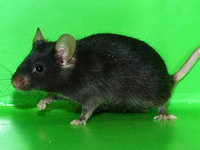Strain Data Sheet
RBRC01916
Strain Information | |
|---|---|
| Image |  |
| BRC No. | RBRC01916 |
| Type | Targeted Mutation |
| Species | Mus musculus |
| Strain name | B6.129-Rnf103<tm1.1Thg>/ThgRbrc |
| Former Common name | Hicky mouse, pKF1KO4.3.1 |
| H-2 Haplotype | |
| ES Cell line | R1 [(129X1/SvJ x 129S1/Sv)F1-Kitl<+>] |
| Background strain | |
| Appearance | |
| Strain development | Developed by Dr. Tamotsu Hashimoto-Gotoh at Kyoto Prefectural University of Medicine in 2001. |
| Strain description | The kf-1 gene was first discovered as a cDNA clone whose mRNA synthesis is elevated in the cerebral cortex of Alzheimer's disease patient (1), and identified later in the rat cerebral cortex after repeated electroconvulsive treatment and chronic antidepressant treatment with SSRI (2). The KF-1 protein is one of the Zinc finger proteins belonging to the RING H2 family, which have been assessed for their ability to facilitate E2-dependent ubiquitination (3). Cells that express exogenous kf-1 result in apoptotic cell death in vitro (unpublished data). Kf-1 deficient mice, called "hicky" mice ("hicky" means hikikomori symptome in Japanese slung, which resembles to "social withdrawal" in English.), display typical anxiety-like behaviors without any other major abnormalities including pathological, physical, behavioral and reproductive aspects. |
| Colony maintenance | Backcross to C57BL/6 (Heterozygote x C57BL/6NJcl) |
| References | Mice lacking the kf-1 gene exhibit increased anxiety- but not despair-like behavior. Tsujimura A, Matsuki M, Takao K, Yamanishi K, Miyakawa T, Hashimoto-Gotoh T Front. Behav. Neurosci., 2, 3389 (2008). 18958194 |
Health Report | |
|---|---|
| Examination Date / Room / Rack | |
Gene | |||||||
|---|---|---|---|---|---|---|---|
| Gene Symbol | Gene Name | Chr. | Allele Symbol | Allele Name | Common Names | Promoter | Diseases Related to This Gene |
| Rnf103 MGI:109483 | ring finger protein 103 | 6 | Rnf103<tm1.1Thg> MGI:4410507 | targeted mutation 1.1, Tamotsu Hashimoto-Gotoh | |||
| loxP | phage P1 loxP | 6 | loxP | ||||
Phenotype | |
|---|---|
| Annotation by Mammalian phenotyhpe ontology | |
| Detailed phenotype data | |
Ordering Information | |
|---|---|
| Donor DNA | phage P1 loxP, mouse Rnf103 genomic DNA |
| Research application | Cre/loxP system Mouse Models for Human Disease Neurobiology Research |
| Specific Term and Conditions | The RECIPIENT of BIOLOGICAL RESOURCE shall obtain a prior written consent on use of it from the DEPOSITOR. In publishing the research results obtained by use of the BIOLOGICAL RESOURCE, a citation of the following literature(s) designated by the DEPOSITOR is requested. Front. Behav. Neurosci., 2, 3389 (2008).In publishing the research results to be obtained by use of the BIOLOGICAL RESOURCE, an acknowledgment to the DEPOSITOR is requested. |
| Depositor | Tamotsu Hashimoto-Gotoh (Kyoto Prefectural University of Medicine) |
| Strain Status |  Frozen embryos Frozen embryos Frozen sperm Frozen sperm |
| Strain Availability | Recovered litters from cryopreserved embryos (2 to 4 months) Cryopreserved sperm (within 1 month) Cryopreserved embryos (within 1 month) |
| Additional Info. | Necessary documents for ordering:
Genotyping protocol -PCR- Mouse of the Month Apr 2007 |
BRC mice in Publications |
|---|
Tsujimura A, Matsuki M, Takao K, Yamanishi K, Miyakawa T, Hashimoto-Gotoh T. Mice lacking the kf-1 gene exhibit increased anxiety- but not despair-like behavior. Front Behav Neurosci 2 4(2008) 18958194 |